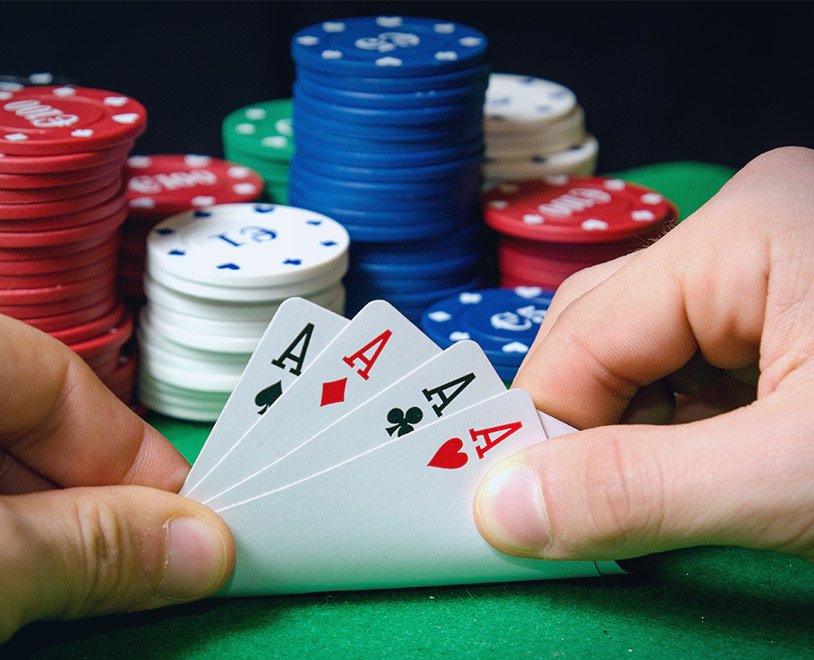It’s no wonder Texas Hold’em became the most popular poker game in the world. This game has only been around since the early 1900s; before that, and even for a long time after, draw poker and stud poker were the preferred ways to play poker for real money. But that all changed in the 1960s, when Hold’em started building popularity in Las Vegas – helped by the arrival of Texas-based “rounders” like Doyle Brunson and Amarillo Slim. Then came the World Series of Poker in 1970, and the rest, as they say, is history.
If you haven’t already, it’s time to get started playing Hold’em at Bovada Poker. This quick online poker guide will show you the ropes, giving you all the Texas Hold’em basics you need to get in the game. It only takes a little bit of know-how to get the jump on your opponents. The more time you spend learning Texas Hold’em and working on it, the more success you’ll have at the tables, but like anything else, it’s best to start at the beginning.
How to Play Online Texas Hold’em Poker

The object in Texas Hold’em is the same as draw poker and stud poker: Make the best possible 5-card poker hand, based on the standard poker hand rankings. You also have the same moves at your disposal: Bet, raise, call, check, or fold. But with Hold’em, everyone starts with just two hole cards, dealt face-down to each player. Then a round of betting happens, and if at least two people have chosen not to fold, three community cards known as the flop are dealt, face-up. All the players still in the pot can use these cards to complete their 5-card hand.
Once the flop is dealt, another round of betting takes place. And once again, if there are still at least two players active once the round is complete, a fourth community card (the turn) is dealt, and betting resumes. If the pot still isn’t claimed, a final community card (the river) is dealt, then the last round of betting takes place. At this point, if there are still multiple players in the pot, the showdown takes place – everyone reveals their hands, and the winner is declared.
Texas Hold-em Game Stages
Look for the FL (Fixed Limit) or NL (No Limit) alongside games posted in our Lobby to determine that stake’s limit type.
Pre-Flop
The button is a graphic symbol that identifies who the dealer is. It moves clockwise after each hand to the next active player.
The blinds are mandatory bets posted at the start of each hand, before any cards are dealt, determined by the small and big bets for that game. Any player that wants to stay in the hand must call the big blind.
The player to the left of the dealer is the first player to get cards, the first to act and the one that posts the small blind. The big blind is posted by the second player, to the left of the small blind.
Example: $10/$20 No Limit Hold’em poker game
Small blind: $10. Big blind: $20.
Any player has the option of sitting out and waiting for the big blind to reach them. If a player sits out and misses posting the big blind, they’ll have to post a big blind to get back in. This stops players from leaving the table before having to post the blinds.
Post-Flop
The dealer then turns over 3 community cards, called the flop. The player to the left of the dealer begins the betting. The action goes around the table as players choose to check, call, raise or fold, returning to the players who posted the blinds.
Then the fourth community card dealt is called fourth street or the turn, which starts another round of betting. In Fixed Limit games the bet increases to the upper stake. Betting continues until all bets are called.
The river is the final community card dealt face up, and begins the last round of betting. The bet amount for Fixed Limit games is the big stake.
Showdown
The showdown happens when all bets have been called. The last player to bet or raise shows their hand first. The best 5-card hand takes the pot.
If all players checked through and nobody bet on the river, the player to the left of the dealer show first with action continuing clockwise, unless a hand is weaker than the winning hand shown. In this case, you can show, or fold without showing, called a muck. If you make a bet and all the other players fold, you ‘buy the pot’ and have the option to show or muck your cards. That’s where the bluffing comes in.
Types of Limits in Texas Hold’em

There’s a reason why Brunson called No-Limit Texas Hold’em the Cadillac of Poker: There’s nothing quite as exciting as pushing all your chips in the middle and saying “All-in.” But this isn’t the only way to play Hold’em when you play poker online. There are three possible betting structures for this game – as well as the Omaha and Omaha Hi/Lo games at Bovada Poker. Here’s a quick look at all three:
Fixed-Limit Hold’em
Known simply as Limit Hold’em, or LHE for short, this was briefly the world’s most popular poker game in the late 1990s and early 2000s. There are only two possible bet sizes in this game: the small bet, and the big bet. This is also how you identify the game: a $2/$4 LHE game features a small bet of $2 and a big bet of $4 (with the blinds at $1 and $2). In pre-flop LHE play, and during the flop, the small bet is used. On the turn and river, the big bet is used.
It’s not just the bet size that’s limited in Limit Hold’em. Most games will cap the betting at a certain number of raises and re-raises per street, usually four or five. Then the next player to act must either call or fold. In general, these limits keep pots smaller than the other betting structures. They also make it more difficult to apply leverage on your opponents and get them to fold.
Pot-Limit Hold’em
With Pot-Limit Hold’em (PLHE), you are now able to bet any amount up to the size of the pot, and there are no caps on the number of raises and re-raises. Games are identified by the size of the blinds, the forced bets that two players at the table (on a rotating basis, to keep things fair) have to contribute before every pot. For example, a $10/$20 PLHE game uses a $10 small blind and a $20 big blind. This betting structure is more commonly found in Omaha, but it will occasionally be used for Hold’em as well, especially during a big tournament festival like the World Series of Poker.
No-Limit Hold’em
This is the grandaddy of ‘em all. With No-Limit Hold’em (NLHE), the gloves come off, and you can bet all the chips in your stack. The minimum bet size is the size of the big blind. There are also some less-familiar rules for poker betting in certain situations, like where you’re only allowed to call instead of raise when someone goes all-in with a short stack – you can learn more about these rules by consulting the FAQ the next time you play at Bovada Poker.
No-Limit Hold’em (CAP)
Even if you’re familiar with No-Limit Hold’em, there’s one special variant that needs to be mentioned. Some No-Limit games you’ll find online are capped at 40 big blinds; this is the maximum number of chips at risk during any one hand. It’s another way for newer players to lower their risk while learning how to play poker correctly, but experienced players will also use these capped games to smooth out the variance and build their bankrolls.
Learning all these betting structures will take some time, but the differences among the three are subtle enough that your overall poker strategy won’t change too much. Not only will you lower your variance by moving beyond No-Limit, you’ll also have a wider range of games to choose from – and game selection is crucial if you want to win money at poker. Play at lower stakes when you’re first starting out with these structures, build your poker strategy from there, and you’ll be one step closer to owning the felt.
The Difference Between Cash Games and Tournaments

Poker as we know it has been around for over 200 years. Poker tournaments, on the other hand, are a much newer invention. They didn’t play any tournaments at the first World Series of Poker in 1970 – they just played cash games for a while, then voted Johnny Moss as the best poker player in the world. The tournament format made its WSOP debut in 1971, and they’ve never looked back.
Cash games are still popular, of course. Thousands of online poker players choose this format and stick with it, while thousands more prefer to play Bovada Poker tournaments. The game itself is the same: Texas Hold’em, Omaha, or Omaha Hi/Lo. But there are important differences between poker tournaments and cash games, and your preference (if you have one) will depend on a number of factors. Here are three of the biggest things that set the two formats apart:
Scheduling
Unless you’re playing a Sit-and-Go poker tournament, you start at a specific time, and you play until you’re eliminated. Cash games run 24/7 at Bovada; you can sit down at any table with an open seat and leave at any time. Your ability to play tournaments will depend on your own personal schedule, but there’s always time for cash poker.
Buy-Ins
The buy-in for a poker tournament is a fixed amount. When you enter a $60+$6 NLHE tournament at Bovada, your losses are capped at $66 (re-buys notwithstanding), and you’ll make a profit if you finish in the money. When you play cash games at Bovada, you can buy in for anywhere between the minimum and maximum, and if you lose your stack, you can buy in again. It’s very important to keep track of this while you’re at the table. Setting a stop-loss of two or three buy-ins will protect you from losing more money than expected.
Blinds
In tournaments, the blinds get bigger as you go along – then the antes are introduced on top of that. The blinds remain the same when you play cash poker. Most online cash players are used to playing Hold’em with uniform stacks of 100 big blinds. In tournaments, you need to learn how to handle deep stacks and short stacks, as well. Try playing both formats to develop your versatility and strengthen your overall Hold’em game.
Best Hands in Texas Hold’em

Knowing the standard poker hand rankings for Texas Hold’em is vital, of course, but you should also take the time to learn the best starting hands when you’re learning how to play poker online. Pocket Aces (AA) are the strongest hole cards possible; you already have the best pair possible, and you might also make the highest-ranking Three of a Kind, Flush or other big hand by the river. Here’s the complete list of top 10 starting hands in Hold’em, ranked in terms of how well they hold up against two random cards once the entire board has been dealt:
1. AA
2. KK
3. QQ
4. JJ
5. TT
6. AKs (suited)
7. 99
8. AQs
9. AKo (off-suit)
10. AJs
What Hands to Push or Fold in Texas Hold’em
There are a lot of decisions to be made when you play Texas Hold’em. But once your stack gets down to a certain size, your decision is relatively easy: Push or fold. That’s because you don’t have enough chips left to apply leverage if you attempt a standard open-raise. This situation usually happens in No-Limit Hold’em tournaments, although it can happen at the cash tables as well.Thanks to game theory and computing power, smart poker players have discovered that you can play “unexploitable” poker once you get in these push-fold situations. That means you can make your decisions almost robotically, knowing that the worst you can do in the long run is break even. But how short is short enough to use a push-fold strategy? That’s a matter for debate. Some players will wait until they’re down to 10 big blinds; others will start shoving when they get below 20 big blinds, and still, others will measure their stacks in terms of M instead of big blinds, taking into account the antes that have to be paid during each orbit around the table.
Pushing and Folding for Poker Profit
Push-fold strategies also change depending on the number of players at the table. When it’s heads-up, you’re in the perfect poker game for using these strategies: It’s just you and your opponent, with no need to worry about things like ICM (Independent Chip Model). The more players you add to the table, the more complicated push-fold strategies get.If you’re serious about winning No-Limit Hold’em poker tournaments, you can find push-fold strategies for heads-up play on the internet. These ranges cover stack sizes from 16 big blinds all the way down to 1.5BB; the shorter you get, the wider range you should be shoving. For example, with 15BB, you should be pushing King-Six offsuit or better, but once you get to 11BB, you should go ahead and push any hand with a King in it. At 7BB, that becomes any Queen.While you’re figuring out your push-fold strategy, don’t forget that you can also call unexploitably when you’re being put all-in. If your opponent has you covered and shoves when you’re down to 12BB, your recommended calling range includes roughly the top 30% of hands in Hold’em, including all pocket pairs, suited Aces, and Broadway hands.
Aggressive Play vs. Conservative Play
Now that you’ve read this Texas Hold’em guide, the most important thing you can do to improve your results is learn some strategy. And as Brunson revealed in his 1979 book Super/System, the bedrock of any smart Hold’em strategy is aggression. By betting and raising, you give yourself two ways to win: Either your opponent folds and you take the pot right now, or you win a very large pot at showdown with the better hand. There’s a time for calling and checking, too, but for the most part, you want to be the one pushing the action. Remember this the next time you play at Bovada Poker, consult our archive for more Hold’em strategy tips, and best of luck at the tables.
